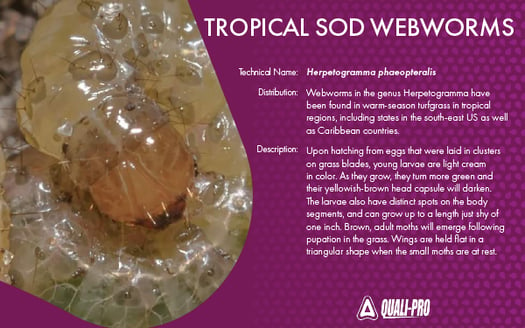Take A Closer Look with Heather Patterson- Technical Services Manager

(Photo by: Daniel D. Dye)
While there are many species of sod webworms, the tropical sod webworm (Herpetogramma phaeopteralis) is one of the more infamous. This destructive insect pest of turf belongs to the order Lepidoptera and family Crambidae, which are known as the crambid snout moths. Yes, webworms will develop into moths; but as indicated by their common name, it’s their larval stage that gets all the attention. Here’s are some facts that will help us get to know the sod webworm:
Sod webworms are caterpillars. Caterpillar is a term that refers to the larval form of moths and butterflies. For webworm caterpillars, they got their name from webbing they create in the grass as they prepare for pupation.
The damage we observe on our turfgrass is caused by the sod webworm caterpillars. Seeing the brown, drab adult moths fluttering in our yards can be an indication of the presence of the larvae, but the adults themselves do not feed on the grass.
If you really want to catch them in the act of feeding, you’ll have to look for sod webworms at night. As they grow, older instars can consume and severely damage large sections of grass blades. Even with intense cases of infestation, tropical sod webworms can injure and weaken turfgrass, but the grass will usually recover.
Tropical sod webworms can be found feeding on all warm season turf grasses, as well as some cool season varieties. Warm season types that are susceptible to their damage include bermudagrass, St. Augustinegrass, and zoysiagrass. Other sod webworms, like Sperry’s lawn moths or western lawn moths, are known to damage bluegrass and bentgrass. Between golf courses, homeowner lawn maintenance, and sod production, turf-care is an important industry that requires solutions to economically detrimental pests, like sod webworms.
If you don’t have one, consider getting one. Sometimes turf stress and damage can look similar from afar, and it’s not until you get up close that you discover the real root of the problem. Since the larvae only get to be ~1-11mm in length, they can sometimes be easy to overlook. Remember: they feed at night. So, if you’re scouting during the day, larvae can usually be found hiding in the thatch.
References
Haydu, J.J., Hodges, A.W., & Hall, C.R. (2006). Economic Impacts of the Turfgrass and Lawncare Industry in the United States. FE632. Gainesville: University of Florida Institute of Food and Agricultural Sciences.http://edis.ifas.ufl.edu/fe632
Reynolds, Casey. (2017). Tropical Sod Webworm. Texas A&M AgriLife Extension Service. ESC-047
Singh, G., Joseph, S.V., and Hudson, W. (2022). Sod Webworms: Biology and Management in Turfgrass. University of Georgia Extension. Circular 1156.
Sutherland, A.M., Flint, M.L., & Harivandi, M.A. (2009). UC IPM Turfgrass Pest Management Guidelines: Sod Webworms. University of California Agriculture and Natural Resources. UC ANR Publication 3365-T.
Tofangsazi, N., & Arthurs, S.P. (2012). Featured Creatures: Common name: tropical sod webworm, scientific name: Herpetogramma phaeopteralis Guenée (Insecta: Lepidoptera: Crambidae). Gainesville: University of Florida Entomology and Nematology Department.
Tofangsazi, N., Cherry, R. H., Meagher, R. L., & Arthurs, S. P. (2014). Tropical Sod Webworm (Lepidoptera: Crambidae): a Pest of Warm Season Turfgrasses. Journal of Integrated Pest Management, 5(4), 1–8. doi:10.1603/ipm14014